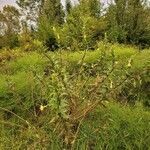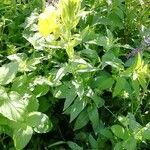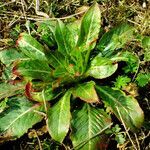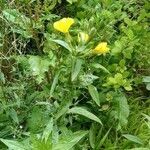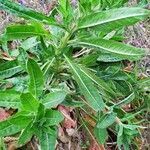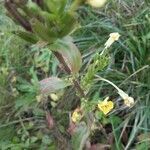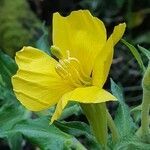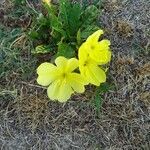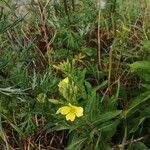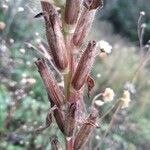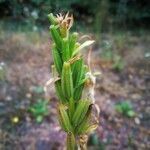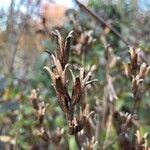Biennial, taprooted herb. Stems to c. 1 m tall, sometimes branched, with scattered long white hairs, with or without hairs with bulbous red bases. Rosette lvs long-petiolate; lamina to 27 × 4 cm, lanceolate to elliptic, with short curly hairs, sometimes hairs ± appressed; midrib pale; margins subentire to denticulate or sinuate; base cuneate to attenuate; apex acute. Cauline lvs with winged petiole or apetiolate; lamina smaller but otherwise similar. Infl. many-or few-flowered, its stem simple or branched; rachis and ovary densely clothed in glandular hairs. Fls crepuscular. Floral tube 3-4.5 cm long, slender, densely clothed in glandular hairs. Buds narrow-lanceolate, erect. Sepals to 3.5 cm long, glandular-hairy; apices mucronate, not or only slightly divergent. Petals 2-3.5 cm long, broad-obovate, yellow. Style exserted by 0.7-2.5 cm, < to > stamens. Capsules 1.5-3.3 cm long, cylindric but widening slightly towards base, ribbed, densely clothed in glandular hairs. Seeds 1.5-2 mm long, sharply angular, very irregular.
Biennial or short-lived perennial, 0.5–2 m; lvs lanceolate to oblong, mostly 1–2 dm, acute or acuminate, entire to repand-dentate, often crisped on the margin, sessile or short-petioled, glabrous to canescent, fls in stiff, terminal, simple or branched, ± leafy-bracteate spikes; hypanthium 2–5 cm; sep 1–3 cm, their appendages terminal, 1–5 mm, connivent for most of their length before anthesis; pet yellow, 1–2.5 cm; anthers 4–7 mm; fr 1.5–4 cm, stout, tapering upwards; seeds 1.2–1.8 mm, angular-prismatic; 2n=14, a complex heterozygote. Fields, roadsides, prairies, and waste places, throughout most of the U.S. and s. Can. July–Sept. More or less divisible into 3 vars.:
A herb. It often grows as a biennial growing one year and flowering and seeding the next. It grows 1.5 m tall and spreads 40-50 cm wide. It has a long fleshy taproot. The leaves are in a ring near the base in the first year. In the second year an erect hairy stem with a smaller leaves appears. The stem is 1 m high. The flowers are yellow. They have 4 distinct petals. The flowers have a sweet scent in the evening. The fruit are hairy seed pods. The seeds are reddish-brown.
Weedy, sparsely pubescent biennial to 2 m tall; leaves lanceolate; rosette leaves sinuate-pinnatifidto denticulate, 8-30 cm long and 1-6 cm wide, their petioles long; cauline leaves denticulate, 5-16 cm long, 15-35 mm wide, subsessile; flowers opening near sunset; mature budserect; hypanthium 2-5 cm long; sepals 1-2 cm long; the free tips 1-4 mm long; petals yellow, 1-2 cm long; capsule thick, cylindric, 14-25 mm long; seeds in 2 rows in each locule, 1.2-1.8 mm long.
Biennial herb, 0.3-2.0 m high. Stems erect; pubescent with short appressed hairs and longer curved or spreading hairs, some arising from red papillae. Leaves sessile or petioles very short; blade narrowly ovate, 80-170 x 20-50 mm, margins strongly dentate, venation prominent. Flowers: floral tube 25-40 mm long; calyx with tube 25 mm long, sepals 8-25 mm long; petals 7-25 mm long, yellow, not fading red; Jan.-Mar. Fruit cylindrical, 14-40 mm long.
Weedy biennial herb, 0.3-2.0 m high. Leaves strongly dentate, venation conspicuous. Capsule cylindrical. Calyx tube 25 mm long. Flowers not more than 40 mm in diameter; yellow, not fading red.
Pending.
